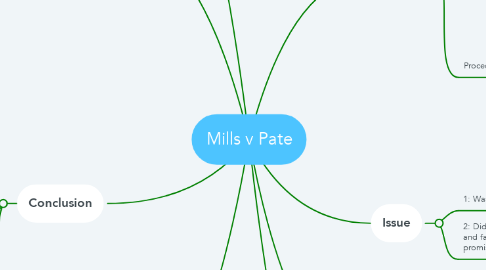
1. Rule of Law
1.1. Legal Principles
1.1.1. Breach of contract: did Dr. Pate make claims and not live up to those claims
1.1.2. Informed Consent: Was Mills aware of the risks of the procedure?
1.1.3. Standard of Care: Did Dr. Pate fail to live up to the standards of his speciality and provide Mills with subpar services?
1.2. Legal Precedent
1.2.1. Patients must be told the risks of their medical decisions
2. Analysis/Application
2.1. The court looked at other cases with breach of express warranty, where a doctor promised a certain breast and did not deliver to the patient
2.2. Dr. Pate failed to meet the accepted medical standard of medical care for cosmetic surgery, saying that his surgery was not appropriate for the patient's desired results and therefore inappropriate to perform.
2.3. Court was compelled by the opinion of the cosmetic surgeon who provided the corrective surgery as an expert in the field of plastic surgery
3. Conclusion
3.1. Issue 1: Was there informed consent? Yes there was and the judge granted summary judgement on this issue. Regardless of what Mills claims to remember, there was evidence of informed consent in signed consent forms
3.2. The second issue must go to trial to determine if Dr. Pate was at fault
4. Importance
4.1. Important because the signed consent form protects doctors from the potential mis-rememberings of patients in terms of what they were told prior to going into a procedure. In addition, the notes that Dr. Pate took are essential because they count as a written record of his time with Mills and informing her of the potential issues with the surgery.
4.2. Mills suing Pate for malpractice in terms of not delivering on a promise is important because it affects how a provider can talk to a patient and the kinds of claims they can make. It is important to not promise results when there are risks involved.
5. Facts
5.1. Parties
5.1.1. Mills - patient, plaintiff
5.1.2. Pate - doctor, defendant
5.2. What happened
5.2.1. Mills got plastic surgery from Dr. Pate and was disappointed with the result and claimed that she was not informed of the possibility of bad results
5.2.2. Mills went to another doctor and got corrective surgery
5.2.3. Mills sues Dr. Pate for malpractice
5.3. Procedural History
5.3.1. Summary judgement, doctor wins
5.3.2. On the first issue, informed consent: doctor wins
5.3.3. On the second issues: question, trial on whether the doctor told Mills she would be beautiful
5.3.4. Appeal on Second issue - of the question of whether or not Mills was told she would look beautiful
